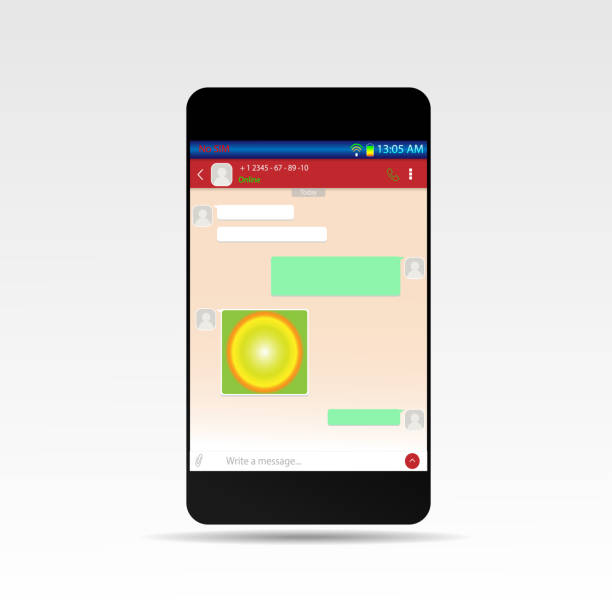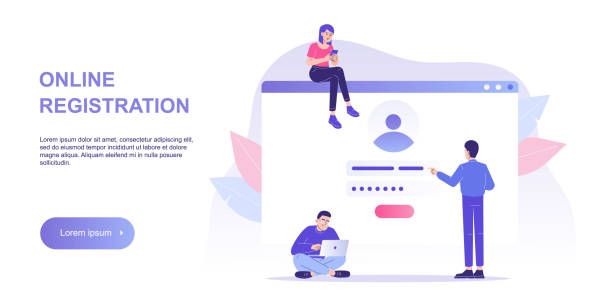Introduction to the Importance of User-Friendly Website Design
In today’s digital world, having a website is not merely about having an online presence; the quality of this presence is of vital importance.
#User_Friendly_Website_Design goes beyond visual aesthetics, meaning creating a space where visitors can easily interact with it, find the information they need, and have a positive experience.
A website that adheres to the principles of #User_Experience (UX) and #User_Interface (UI) not only attracts more audiences but also converts them into loyal customers.
If a website is complex, slow, or inaccessible, users quickly leave it and turn to your competitors.
This leads to an increased Bounce Rate, a decreased Conversion Rate, and ultimately severe damage to brand reputation.
Today, paying attention to the real needs of users and providing simple and efficient solutions is the cornerstone of any digital success. User-centric websites, by accurately understanding visitor behavior and expectations, pave the way for achieving business goals.
In fact, user-friendly website design is a strategic investment that yields significant returns in the long term. In this explanatory article, we will delve into various aspects of this vital concept to guide you on the path to creating a truly effective and pleasant website.
Is your current e-commerce site design causing you to lose customers and sales?
Rasaweb is your solution with modern and user-friendly e-commerce website designs!
✅ Significant increase in conversion rates and sales
✅ Strong branding and building customer trust
⚡ Get a free e-commerce website design consultation from Rasaweb!
Key Principles of User Experience Design
#User_Experience or UX, forms the core of a successful website, and user-centric web design heavily relies on it.
To ensure that visitors enjoy your site and achieve their goals, special attention must be paid to key UX principles.
The first principle is “Discoverability”; users should easily be able to find the content and functionalities they need.
This is achieved through clear navigation and a logical structure.
Second is “Accessibility,” which means designing for everyone, including people with disabilities.
The site must be compatible with assistive technologies and make information understandable for all.
The third principle is “Consistency”; design elements, writing style, and functionality should be uniform across the site so that users feel familiar and comfortable.
“Feedback” is also vital; the system should react to user actions, for example, by showing a form’s success or a page loading.
“Efficiency” means users can complete their tasks with minimal effort and time, which includes optimizing processes and reducing unnecessary steps.
Finally, “Learnability”; the site should be designed so that new users quickly become familiar with it and can use it without needing specific training.
These principles provide guidance for creating a positive digital experience and optimizing the website to attract and retain an audience.
The Importance of User Interface Design and Visual Hierarchy
After understanding the principles of #User_Experience, it’s time for #User_Interface_Design (UI), which is responsible for the look and feel of users’ interaction with the website.
Good UI enhances excellent UX.
An attractive and visual user interface not only makes the site beautiful but also simplifies users’ mental processes for accessing information.
“Visual Hierarchy” is one of the most important elements in UI design.
This concept means arranging page elements in such a way that it guides the user’s eye, in order of importance, from main information to minor details.
Using different font sizes, color contrast, whitespace, and intelligent positioning of elements all contribute to creating visual hierarchy.
For example, a large, bold heading immediately grabs attention, while smaller-font body text provides more details.
#Color_Theory and #Typography also play a significant role in UI; colors can evoke emotions and strengthen the brand, while fonts affect readability and the overall tone of the site.
Finally, images and icons must also be carefully chosen to be both aesthetically pleasing and convey a clear meaning.
Click here to preview your posts with PRO themes ››
| Feature | Good UI | Poor UI |
|---|---|---|
| Navigation | Clear, simple, easy to access | Complex, hidden, illogical |
| Text Readability | High contrast, appropriate font size, sufficient space | Low contrast, small font, cluttered |
| Button Design | Clear, clickable, with visual feedback | Undetectable, small, no feedback |
| Forms | Short, with clear guidance, quick error detection | Long, ambiguous, unclear errors |
| Responsiveness | Compatible with all device types and screen sizes | Optimized only for desktop, broken on mobile |
Mobile Responsiveness and Accessibility
In the current era, where smartphones and tablets have become the primary tools for internet access, #Responsive_Design is not an option, but a necessity for every user-friendly website design.
Your website must display flawlessly on every screen size, from large desktops to smartwatches.
This approach, often referred to as “Mobile-First,” means that design begins with smaller devices and then expands to larger screens.
This ensures that mobile users have a smooth experience without needing to zoom or horizontal scroll.
In addition to responsiveness, “Web Accessibility” is also of paramount importance.
Websites must be usable by all individuals, including those with visual, auditory, motor, or cognitive disabilities.
Adherence to WCAG (Web Content Accessibility Guidelines), such as using alt text for images, sufficient color contrast, keyboard navigation, and proper semantic structure, helps create an inclusive experience.
An accessible website not only demonstrates your social responsibility but also dramatically expands your audience reach. These two aspects, responsiveness and accessibility, complement each other and form the foundation of a truly comprehensive and successful website.
Do you dream of a thriving online store but don’t know where to start?
Rasaweb is your comprehensive solution for e-commerce website design.
✅ Attractive and user-friendly design
✅ Increased sales and revenue⚡ Get a free consultation
Website Speed and Performance Optimization
Website loading speed is one of the most critical factors in determining #User_Experience and visitor satisfaction.
In today’s world, users expect websites to load within a few seconds, and even small delays can lead to site abandonment and audience loss.
Optimizing #Site_Speed not only directly impacts user-friendliness but is also an important factor in SEO ranking. Search engines like Google prioritize faster websites.
Several techniques exist to improve performance.
Compressing images without losing quality is one of the fundamental methods; large images can impose a significant burden on page loading time.
Using caching allows the website to store static content for subsequent visits, increasing access speed.
Minimizing CSS and JavaScript files by removing whitespace and unnecessary code helps reduce the size of these files and, consequently, loading speed.
Additionally, using a reputable hosting provider and optimizing server response also play a significant role in the overall website speed.
The ultimate goal is to provide a fast and smooth website so that users can access content and services without any interruptions, resulting in a truly user-friendly website.
Content Strategy for More Engagement
Alongside #User_Friendly_Website_Design in terms of visual and technical aspects, content also plays a vital role in creating a positive user experience.
Even the best design cannot attract and retain users without engaging, useful, and relevant content.
#Content_Strategy involves planning, creating, and managing content that not only meets the audience’s needs but also aligns with your business goals.
Your content should be clear, concise, and easy to understand.
Using short paragraphs, bulleted lists, subheadings, and relevant images helps improve readability.
Question-provoking content can stimulate users’ curiosity and encourage them to interact more with the site; for example, a question at the beginning of an article whose answer is hidden later in the content.
Clear and attractive Calls to Action (CTAs) encourage users to take next steps such as signing up, purchasing, or downloading.
Furthermore, providing entertaining content such as infographics, videos, or short quizzes can make the user experience more pleasant and increase the user’s time on site.
Remember that your content should offer real value to the user and accompany them at every stage of their journey on the website.
A website with strong and strategic content is truly a user-friendly website that users are eager to return to.
Click here to preview your posts with PRO themes ››
User Testing and Feedback Integration
Building a user-friendly website is an iterative process that doesn’t end with a one-time design.
To ensure your site truly meets user needs, #User_Testing and collecting #User_Feedback are essential.
#Usability_Testing allows you to observe actual user behavior and identify underlying issues that might have been overlooked in the initial design.
These tests can involve giving users specific tasks and observing how they interact with the site.
A/B Testing is also a powerful method for comparing two different versions of a page or design element to see which performs better.
After collecting feedback, the important step is to analyze it and identify common patterns.
Do users have trouble finding the purchase button? Is the registration form too long? Answering these questions provides a basis for future improvements.
Integrating this feedback into the design process allows you to continuously optimize your site and align it with changing user expectations. This cycle of continuous feedback and improvement is the heart of a truly user-friendly website design and ensures your website is constantly evolving and providing the best possible experience to users.
| Method | Description | Advantages |
|---|---|---|
| Usability Testing | Observing real users performing specific tasks on the site | Discovering unexpected problems, observing real behavior |
| A/B Testing | Comparing two versions of a page/element to determine better performance | Optimizing specific elements, data-driven decision making |
| Surveys and Questionnaires | Collecting quantitative and qualitative feedback from a large number of users | Overall perspective, identifying broad trends |
| User Interviews | In-depth conversations with users to understand needs and motivations | Deep insights, understanding why behaviors occur |
| Heatmaps and Eye Tracking | Analyzing areas where users look/click the most | Visual understanding of user attention, identifying hotspots |
Future Trends in User Experience
The world of #Web_Design and #User_Experience is constantly evolving, and to maintain a user-friendly website design, one must be aware of future trends.
One of the most important upcoming trends is the integration of #Artificial_Intelligence (AI) into the design process and personalization of the user experience.
AI can analyze user data to provide customized content and suggestions, making the website user-centric in an unprecedented way.
Voice User Interfaces (Voice UI) are also growing and gaining importance for hands-free and eyes-free interactions, especially with the increasing popularity of voice assistants like Siri and Alexa.
Augmented Reality (AR) and Virtual Reality (VR) also have great potential to create interactive and immersive experiences on websites, particularly in areas like online shopping and education.
Other trends include #Micro_interactions, which are small animations and feedback to enhance the user’s feeling of interaction, and “User Journey” design, which focuses on creating a seamless and pleasant path from the first contact to the end of the interaction.
These developments indicate that the future of user experience is moving towards smarter, more personalized, and multi-sensory interactions.
Professionals must adapt to these emerging trends to build websites that remain relevant and user-friendly not only now but also in the years to come.
Are you frustrated by losing customers who visited your site to buy?
Rasaweb is your specialized solution for having a successful online store.
✅ Significantly increase your online sales
✅ Build trust and professional branding with customers⚡ Get a free consultation from Rasaweb experts!
The Relationship Between SEO and Usability
At first glance, #SEO (Search Engine Optimization) and #Usability might seem like two separate domains, but in reality, they have an inseparable connection and both are essential for the success of a user-friendly website design.
Search engines like Google are increasingly focusing on #User_Experience and consider it a crucial factor in ranking web pages.
Google’s Core Web Vitals (including loading speed, visual stability, and first input delay) are a clear example of this attention.
A website that loads quickly, is responsive, has easy navigation, and provides relevant and high-quality content is not only pleasant for users but also sends positive signals to search engines.
These signals include a low bounce rate, high time on site, and higher conversion rates, all of which contribute to SEO. In other words, a #user_friendly website automatically provides the necessary conditions for good SEO.
Instead of trying to trick Google’s algorithms, it’s better to focus on meeting user needs.
When you launch a website optimized for user experience, you are essentially building a strong foundation for higher rankings in search results.
This synergy between SEO and usability is a vital guide for every web professional seeking long-term online success.
Click here to preview your posts with PRO themes ››
Conclusion: Building a Successful Website
As we have seen in this explanatory article, #User_Friendly_Website_Design is a comprehensive and multifaceted concept that goes beyond merely the aesthetic appearance of a website.
This approach includes a deep understanding of user needs and behaviors, adherence to #User_Experience and #User_Interface principles, ensuring mobile responsiveness and accessibility, optimizing speed and performance, and creating engaging and useful content.
Each of these components plays a vital role in building a #Successful_Website that not only attracts visitors but also retains them and helps achieve your business goals.
Investing in user-friendly website design is not an expense, but a strategic investment that leads to increased customer satisfaction, improved conversion rates, and strengthened brand reputation.
Ultimately, it must be remembered that the digital world is constantly changing, and a user-friendly website must also continuously evolve.
Collecting feedback, conducting continuous testing, and keeping pace with new trends are of paramount importance.
By focusing on these principles, you can build a website that is not only visually appealing but also provides an unparalleled user experience and assists you on the path to #Digital_Success.
Continuous optimization for a user-friendly website design is the key to excelling in today’s competitive online landscape.
Frequently Asked Questions
And other services by Rasa Web Advertising Agency in the field of advertising
Smart Direct Marketing: Transform campaign management with attractive UI design.
Smart Marketplace: Designed for businesses seeking digital branding through intelligent data analysis.
Smart Link Building: An effective tool for increasing sales by optimizing key pages.
Smart Google Ads: Revolutionize click-through rate increase with SEO-driven content strategy.
Smart Advertorials: A creative platform for improving customer acquisition with marketing automation.
And over a hundred other services in the field of internet advertising, advertising consultation, and organizational solutions
Internet Advertising | Advertising Strategy | Advertorials
Sources
User-Friendly Website UX Design Principles
What is User Experience?
What is UI/UX Design?
Examples of Successful UX Design
? To soar in the digital world and reach more customers, Rasaweb Afarin Digital Marketing Agency is with you, offering creative and results-driven solutions. From custom website design and SEO optimization to professional social media management, we give your business a powerful identity that resonates with your audience. Contact us and transform the future of your business.
📍 Tehran, Mirdamad Street, next to Bank Markazi, Kazerun Jonoubi Alley, Ramin Alley, P.O. Box 6














